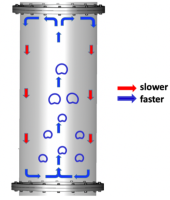Tracer techniques to Characterize the Gas and Solids Mixing in Fluidized Beds

This webinar focuses on the work PSRI has done to quantify the behavior of gases and solids in fluidized bed systems. To track the path of gas, PSRI uses helium injections at points of interest and uses thermal conductivity detectors to read the concentration of helium at the desired probe locations. For solids, small amount of the same bed material dyed with fluorescent dye and injected into the system. The illuminating fiber shines UV light on the material and, if the presence of dyed particles in the measuring volume, will then emit a light of certain wavelength back to the receiving fiber, which is received by a photodiode. Both the gas and solid tracers are introduced into the system in small concentrations relative to the system inventory. Currently in the Gas-Solid Contact program, PSRI is investigating the use of an adsorbing tracer, carbon dioxide, and comparing it to the helium tracer, which is non-adsorbing. The goal of the program is to quantify how efficiently the adsorbing tracer is contacting (adsorbing) to the catalyst, as well as how the bed behavior affects this contacting.
| Presenter: | Christof Dee |
| Platform: | Zoom |
| Registration Reqired? | YES |
| Will this webinar be Recorded? | YES (Replay will be on PSRI.org 24 hours after session) |
Event Properties
| Event Date | 08-15-2023 |
| Event End Date | 08-15-2023 |
| Individual Price | Free |
PSRI Restricted: Authorized Access Only
